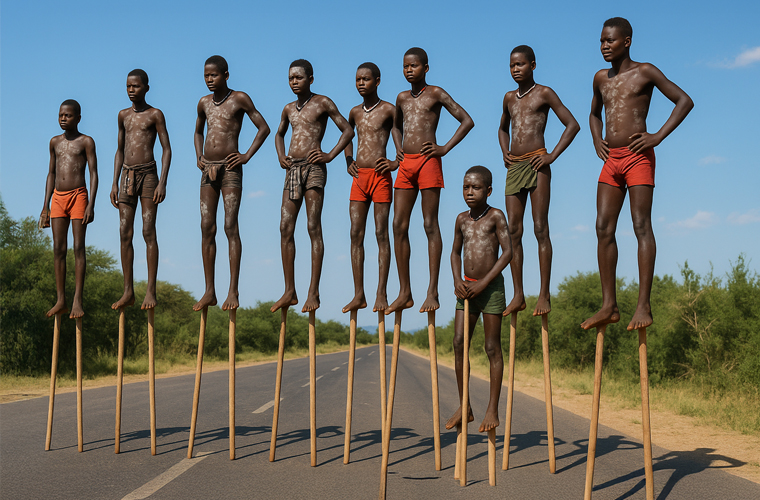Grace on Stilts
In the sun-baked expanses of Ethiopia’s Lower Omo Valley, where the Omo and Weyto rivers carve through arid savannas and marshy lowlands, the Banna tribe—a resilient Omotic ethnic group —lives. The Banna tribe numbers around 45,000 people. Known for their pastoral lifestyle of cattle herding, beekeeping, and small-scale farming, the Banna have captivated the world with one of Africa’s most mesmerizing traditions: stilt-walking by their young boys, affectionately called the “Stick Boys.” These lithe figures, balanced precariously on towering wooden poles, glide across the landscape like ethereal guardians, blending necessity, skill, and symbolism into a living work of art.
Origins: From Survival to Spectacle
The roots of the Banna’s stilt-walking tradition trace back centuries, born out of the harsh realities of their environment. The Omo Valley teems with dangers—snakes, scorpions, and other wild animals lurk in the tall grasses and swampy terrains that the Banna navigate daily while herding their precious cattle. Legend has it that young men first fashioned stilts from sturdy local wood to elevate themselves above these threats, gaining a vantage point to spot predators and guide livestock to water and grazing lands. This practical innovation, which reached heights of up to 10 feet, also allowed them to cross streams and traverse muddy terrain during the long migrations of the dry season.
What began as a survival tactic evolved into a cultural cornerstone. Closely related to neighboring tribes like the Hamar, the Banna share linguistic and ritual influences, with their language blending Hamar-Banna dialects. Today, the stilts—simple poles with footrests strapped to the legs—serve not just for protection but as a bridge between the earthly and the divine, with stilt-walkers believed to hold a spiritual connection to the heavens.
A Rite of Passage: Symbolism and Strength
For the Banna, stilt-walking is far more than a skill; it’s a profound rite of passage marking the transition from boyhood to manhood. Young boys begin learning as early as toddler age, starting with short stilts akin to training wheels, gradually increasing the height as their confidence and balance grow. Mastering the art demands years of practice, honing not only physical prowess but also mental fortitude. Gracefully striding on these unstable perches demonstrates responsibility, independence, and the “temerity of a lion”—qualities essential for a future herdsman or warrior.
During ceremonies, the spectacle intensifies. Boys paint their bodies in white stripes, don vibrant regalia adorned with beads and feathers, and perform synchronized walks that celebrate weddings, harvest festivals, and initiations. These displays foster tribal pride, preserve oral histories, and reinforce community bonds, turning the Stick Boys into revered figures who communicate joy, status, and spirituality through their elevated dance. In a society where cattle represent wealth and status, a proficient stilt-walker signals readiness to protect and provide, echoing the tribe’s deep-seated values of resilience and harmony with nature.
Mastering the Art: Daily Life and Skill-Building
Daily life in Banna villages, often clustered around Chari Mountain or near Dimeka town, revolves around this tradition. Boys spend hours herding cattle across vast plains, their stilts allowing them to scan for threats while keeping their feet safely aloft. Elders mentor the young, passing down techniques passed through generations—balancing weight shifts, leaping small obstacles, even racing competitors in friendly displays of agility.
Beyond herding, the Banna’s ingenuity shines in their crafts: intricate wood carvings for stilts and tools, woven baskets, and ceramics that reflect their environment’s stark beauty. Hunters and farmers by trade, they supplement their pastoral economy with wild honey harvesting—a perilous task made safer (and perhaps swifter) on stilts. This multifaceted lifestyle underscores the Stick Boys’ role not as performers, but as integral stewards of their people’s survival and creativity.
Preservation Amid Change: Tourism and the Future
Modern influences have softened the edges of this ancient practice. Urbanization, climate shifts, and access to roads have reduced daily reliance on stilts for herding, confining the tradition more to ceremonial and performative contexts. Yet, this evolution has sparked a renaissance through tourism. Visitors flock to Omo Valley markets and festivals, drawn by the Stick Boys’ hypnotic routines, which now generate income and global awareness. Researchers and filmmakers document these moments, ensuring the Banna’s story echoes far beyond their valley.
Challenges persist—environmental degradation threatens grazing lands, and cultural erosion looms with younger generations eyeing city lights. But the tribe’s commitment to preservation endures. Community-led initiatives teach stilt-walking in schools, blending it with education to instill pride in the next cohort of Stick Boys. As one elder might say, the stilts lift more than bodies; they elevate a legacy, keeping the Banna’s spirit towering above time.
In the shadow of acacia trees, as the sun dips low over the Omo, the Stick Boys remind us of humanity’s boundless adaptability. Their strides across the stilts are a testament to a culture that dances with danger, honors its past, and steps boldly into the unknown—a graceful rebellion against the ordinary in one of Earth’s most extraordinary corners.

